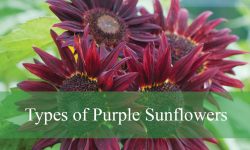Choosing the best flowers to grow in Georgia can bring vibrant colors and life to any garden. Georgia’s climate, with hot summers and mild winters, requires plants that can withstand heat and humidity while blooming beautifully. Picking the right flowers ensures a garden that thrives and looks stunning throughout the growing season.
This complete guide highlights the best flowers to grow in Georgia, focusing on species that are both hardy and visually appealing. From bright annuals to reliable perennials, each flower is selected for its ability to flourish in Georgia’s unique conditions. Detailed care instructions and pictures will help gardeners of all levels create the perfect floral display.
Planting the best flowers to grow in Georgia means enjoying a long season of blooms and supporting local pollinators like bees and butterflies. These 12 top picks will add charm and resilience to your garden, making it a beautiful and lively space year after year.
Best Flowers to Grow in Georgia for Every Season
Black-eyed Susan (Rudbeckia hirta)

Black-eyed Susan is a standout wildflower known for its vivid yellow petals surrounding a prominent, dark brown central disk. The daisy-like flowers typically measure 2 to 3 inches across and grow atop stiff, hairy stems that can reach up to 3 feet in height. Its foliage is coarse and rough to the touch, with lance-shaped leaves arranged alternately along the stem. This native wildflower gives off a rustic, natural charm that makes it ideal for both wildflower meadows and formal borders in Georgia gardens.
In terms of blooming time, Black-eyed Susans flower profusely from mid-summer to early fall. In Georgia’s climate, this bloom period often extends even longer thanks to the region’s warm and sunny weather. The plant is a magnet for pollinators like bees, butterflies, and even some birds, making it a valuable addition to any wildlife-friendly garden. The flower’s striking contrast of yellow and black also adds bright visual interest during the hotter months when many other flowers begin to fade.
This plant is extremely well-suited for Georgia’s conditions, especially in full sun and well-drained soil. It’s remarkably drought-tolerant once established, though moderate watering during extended dry periods will enhance blooming. Black-eyed Susan can grow in various soil types, including clay, loam, and sandy soils, as long as there’s adequate drainage. Avoid overwatering, as soggy conditions can lead to root rot and fungal diseases.
To grow Black-eyed Susan successfully in Georgia, sow seeds directly in the garden in early spring after the last frost. You can also start them indoors 6–8 weeks prior. Thin seedlings to prevent overcrowding and encourage air circulation. Deadheading spent flowers encourages continuous blooming, and cutting the plants back in fall helps maintain tidy beds. Being a self-seeding plant, it may naturalize in the garden over time, returning stronger each year.
Coneflower (Echinacea purpurea)
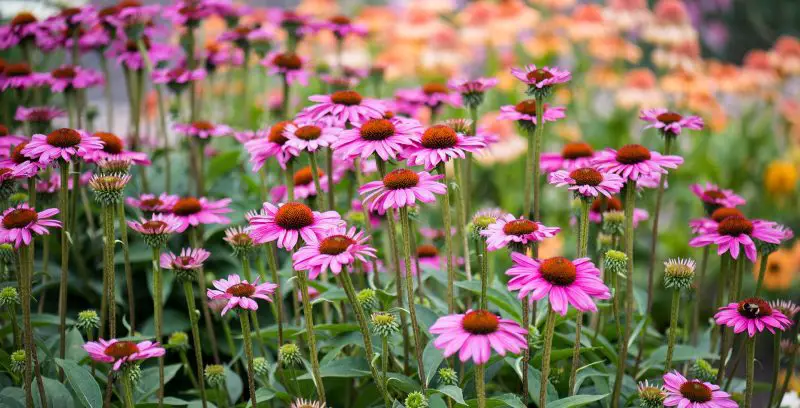
Coneflower, scientifically known as Echinacea purpurea, is a hardy, eye-catching perennial native to North America that performs beautifully in Georgia’s warm and sunny climate. It features large, daisy-like flowers with purple to pink petals that gracefully droop away from a spiny, orange-brown central cone. The flower stems are upright and sturdy, typically reaching 2 to 4 feet in height, and the dark green leaves are rough and lance-shaped, providing a lush background for the blooms.
Blooming from late spring to late summer, coneflowers bring long-lasting color to Georgia gardens. In milder southern regions of the state, their bloom season may even extend into early fall. These flowers are highly attractive to pollinators such as bees, butterflies, and hummingbirds. Additionally, their seed heads persist through winter, providing food for birds and adding structure to the winter landscape.
Coneflowers thrive in full sun and tolerate Georgia’s hot summers exceptionally well. They prefer well-drained soil and can handle periods of drought, making them ideal for low-maintenance or xeriscape gardens. While they do best in moderately fertile soil, they are not fussy and can grow in sandy, loamy, or clay soils. Overwatering and poorly drained soil should be avoided, as coneflowers are prone to root rot in soggy conditions.
To grow coneflowers in Georgia, you can either transplant nursery-grown specimens or sow seeds directly into the garden in early spring or fall. Space plants about 18 to 24 inches apart to ensure good air circulation. Once established, they require minimal care—just deadhead to encourage more blooms or leave spent flowers to go to seed. Every few years, clumps can be divided in early spring to maintain vigor and prevent overcrowding.
Zinnias (Zinnia elegans)

Zinnias are popular annuals cherished for their vibrant, long-lasting blooms and their ability to withstand Georgia’s hot and humid summers. They produce a wide range of flower colors—red, pink, yellow, orange, white, and even bi-colored varieties—on upright stems with oval to lance-shaped green leaves. Depending on the variety, Zinnias can range in height from 6 inches to over 3 feet, making them versatile for flower beds, containers, and borders.
These flowers bloom continuously from early summer until the first frost, making them one of the longest-blooming annuals in Georgia gardens. Their profuse flowering nature and vivid colors attract pollinators, including butterflies, bees, and hummingbirds. Some gardeners also use Zinnias as cut flowers due to their sturdy stems and excellent vase life, making them a dual-purpose addition to the landscape.
Zinnias grow best in full sun and need at least 6 hours of direct sunlight daily to produce abundant flowers. They prefer well-drained, moderately fertile soil and benefit from regular watering at the base to prevent powdery mildew, a common issue in Georgia’s humid conditions. However, Zinnias are generally low-maintenance and can tolerate short periods of drought once established.
To cultivate Zinnias in Georgia, sow seeds directly into garden beds after the last spring frost, as they dislike root disturbance. Thin seedlings to allow for good air circulation. For extended blooms, deadhead faded flowers regularly. Staggering plantings every few weeks can ensure a continuous wave of color throughout the growing season. Apply mulch to retain soil moisture and suppress weeds, especially in high heat areas.
Lantana (Lantana camara)

Lantana is a heat-loving tropical perennial often grown as an annual in cooler parts of Georgia. It features vibrant clusters of small, tubular flowers in multi-colored combinations, including yellow, orange, red, pink, and purple. The flowers sit atop square-shaped stems with rough-textured, aromatic green leaves. Some varieties form dense, low mounds, while others grow as sprawling shrubs or trailing plants ideal for hanging baskets and ground cover.
Lantana blooms continuously from late spring through the first frost in Georgia’s long growing season. The flowers are highly attractive to butterflies, bees, and hummingbirds, making them an excellent choice for pollinator gardens. In warmer areas of Georgia, especially Zones 8b to 9a, Lantana may overwinter and return the following year, while in colder zones it is typically grown as an annual.
Lantana thrives in full sun and tolerates Georgia’s hot, humid climate with ease. It performs best in well-drained soil and is drought-tolerant once established, though it benefits from occasional deep watering during extended dry periods. Avoid overwatering, as soggy conditions can lead to root rot. It’s also salt-tolerant, making it a good choice for coastal gardens in southern Georgia.
To grow Lantana successfully, plant it in a sunny spot after all danger of frost has passed. Space plants according to variety size, usually 12 to 24 inches apart. Prune back plants periodically to encourage bushier growth and more blooms. Deadheading is not necessary, though removing spent flowers can enhance appearance. In Zones 8 and warmer, mulch heavily in late fall to help plants survive winter.
Marigolds (Tagetes spp.)
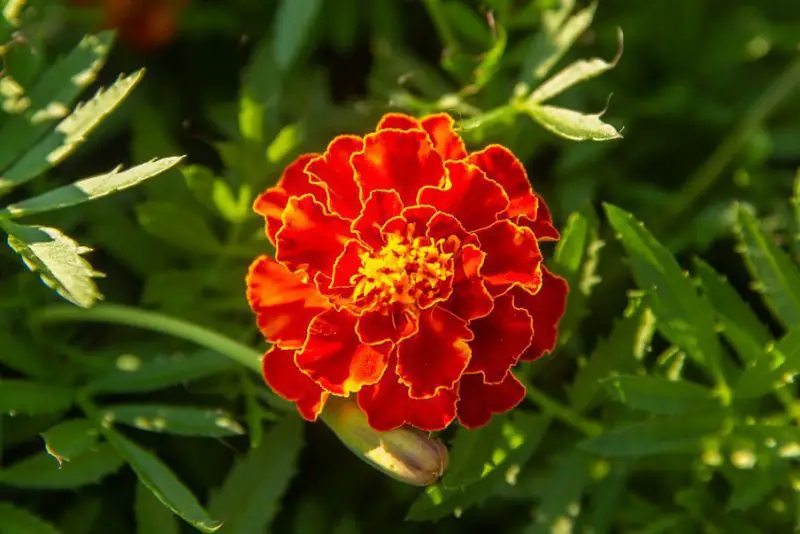
Marigolds are vibrant, cheerful annuals widely appreciated for their bright, bold colors ranging from sunny yellows to deep oranges and reds. Their compact, bushy growth habit and profuse blooms make them a favorite choice for adding a splash of color to summer gardens. The flowers are usually round and dense with petals that can be either smooth or ruffled, giving gardeners a variety of shapes and sizes to choose from.
Marigolds bloom continuously from late spring through fall, flourishing especially in Georgia’s hot summer months. Their strong, spicy scent is known to repel common garden pests such as nematodes, aphids, and whiteflies, making them excellent companion plants for vegetables and other crops. This natural pest deterrent benefit, combined with their bright hues, makes marigolds an indispensable part of many Georgia home gardens.
These flowers thrive best in full sun and well-drained soil, tolerating a range of soil types as long as drainage is adequate. Marigolds are drought-tolerant but will perform best with regular watering during extended dry spells. They prefer warmer conditions, which suits Georgia’s climate perfectly, and can be grown as annuals in USDA Zones 2 through 11, giving them a broad geographic adaptability.
For successful growth in Georgia, sow marigold seeds directly in garden beds after the last frost date or start them indoors 6–8 weeks earlier. They require minimal care aside from occasional deadheading to encourage prolonged blooming. Because they grow quickly and flower heavily, marigolds are also a popular choice for containers, borders, and mass plantings where their color and pest-repellent qualities can be best utilized.
Coreopsis (Coreopsis spp.)

Coreopsis, commonly known as tickseed, is a charming native perennial known for its bright, daisy-like flowers, most often seen in cheerful golden yellow but also available in shades of red, orange, and pink. The plants have delicate, fern-like foliage and produce numerous blooms that create a radiant display over a long period. They typically grow in clumps, reaching heights of 1 to 3 feet, adding both texture and color to garden beds.
In Georgia, coreopsis blooms profusely from late spring through summer, often extending into early fall with deadheading. Their vibrant flowers are a magnet for pollinators such as bees and butterflies, making them excellent for wildlife gardens. The prolonged bloom season and bright colors add continuous visual interest to sunny garden spaces.
Coreopsis is exceptionally drought-tolerant once established, which suits Georgia’s warm climate and variable summer rainfall. These plants prefer full sun and well-drained soils but can tolerate poorer soils, including sandy or rocky ground. They are low-maintenance perennials that require little supplemental watering or fertilization once settled, thriving best in USDA Zones 4 through 9.
To grow coreopsis successfully in Georgia, sow seeds or plant nursery starts in spring after the last frost. Space plants about 12 to 18 inches apart for good air circulation and to prevent overcrowding. Regular deadheading encourages more blooms and helps maintain a neat appearance. Coreopsis also benefits from dividing clumps every few years in early spring to keep plants vigorous and productive.
Azaleas (Rhododendron spp.)

Azaleas are beloved flowering shrubs that hold a special place in Southern gardens, including those in Georgia, where they thrive in the region’s acidic soils and mild climate. These shrubs produce clusters of trumpet-shaped flowers in a variety of colors, including pink, white, red, and purple. Their glossy, evergreen or deciduous leaves provide a rich green backdrop that highlights the vibrant spring blooms beautifully.
In Georgia, azaleas typically bloom in early to mid-spring, creating spectacular displays in landscapes, woodland gardens, and shaded borders. Many varieties also offer reblooming potential, such as Encore azaleas, which can flower multiple times from spring through fall. The spring bloom period aligns well with Georgia’s climate, and their lush foliage adds year-round appeal.
Azaleas prefer partial shade, especially in the hot Georgia summer, and need well-drained, acidic soil enriched with organic matter. Consistent moisture is important, but the soil should never be soggy. They thrive best in USDA Zones 6 through 9, which covers most of Georgia. Mulching helps retain soil moisture and protects roots from temperature extremes.
Plant azaleas in early spring or fall for best establishment. Avoid planting too deep and water regularly during dry spells, particularly in the first growing season. Pruning after flowering encourages a fuller shape and removes dead wood. Selecting native azaleas or hardy cultivars will improve success and reduce maintenance in Georgia gardens.
Gardenias (Gardenia jasminoides)
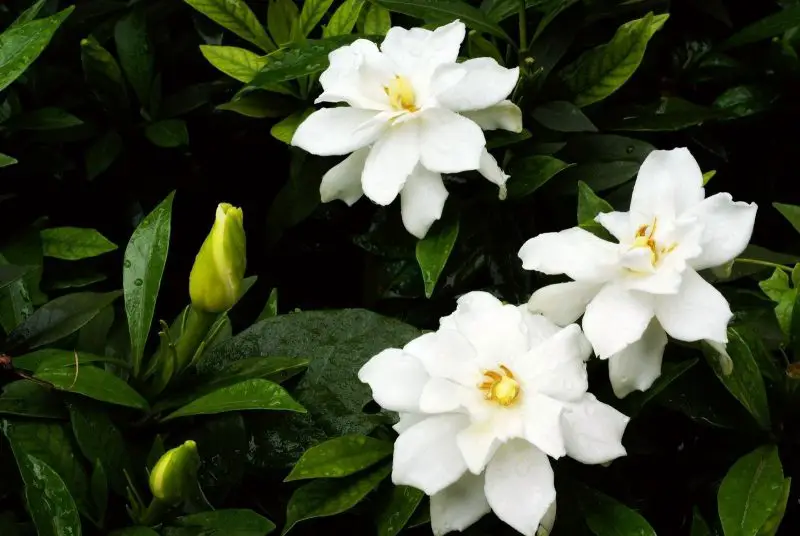
Gardenias are prized for their intoxicating fragrance and elegant creamy white blooms, making them a standout feature in many Georgia gardens. These evergreen shrubs have glossy, dark green leaves that contrast beautifully with their large, waxy flowers. Gardenia blossoms typically range from 2 to 5 inches in diameter and provide a luxurious, tropical feel to landscapes.
In Georgia, gardenias bloom mainly in late spring and early summer, with some varieties offering sporadic blooms throughout the warmer months. Their rich, sweet fragrance fills the garden and makes them popular choices for planting near patios and walkways where the scent can be enjoyed up close. The flowers are also used frequently in floral arrangements and corsages.
Gardenias thrive in Georgia’s warm, humid climate but require some care to flourish. They prefer partial shade to protect from the harsh afternoon sun and need acidic, well-drained soil rich in organic matter. Regular watering and high humidity help maintain healthy growth, but good drainage is crucial to prevent root diseases. They are best suited for USDA Zones 8 to 11, though some cold-hardy varieties can grow in Zone 7 with protection.
To grow gardenias successfully in Georgia, plant them in sheltered locations with morning sun and afternoon shade. Mulch to conserve moisture and regulate soil temperature. Fertilize with acid-loving plant food during the growing season, and prune lightly after flowering to shape the plant. Monitoring for pests like whiteflies and aphids is important, as gardenias can be susceptible to infestations in humid conditions.
Camellias (Camellia japonica, C. sasanqua)
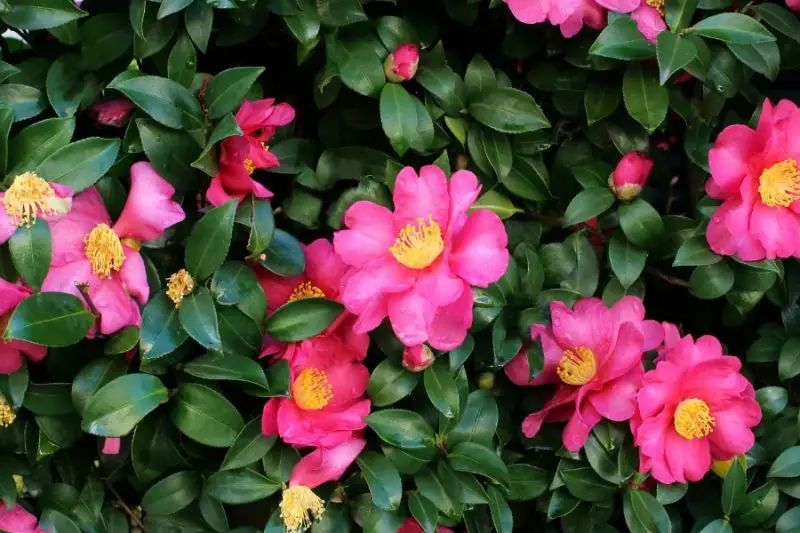
Camellias are elegant, evergreen shrubs prized for their glossy dark green leaves and stunning rose-like flowers that bloom in winter and early spring. Camellia japonica typically produces large, showy flowers in shades of red, pink, and white, while Camellia sasanqua has smaller but more numerous blooms that often appear in fall and early winter. Their lush foliage provides year-round interest in Georgia gardens.
In Georgia’s acidic soils, camellias thrive beautifully, making them a staple in Southern landscapes. They are suited for USDA Zones 7 through 9, where the winters are mild enough to protect their delicate buds. These shrubs prefer partial shade, especially from the hot afternoon sun, which helps protect their leaves from scorching and prolongs bloom duration.
Camellias require well-drained, acidic soil rich in organic matter to flourish. They benefit from mulching to maintain moisture and soil temperature, and regular watering, especially during dry spells, supports healthy growth. Fertilizing with acid-loving plant food in early spring encourages robust blooms and strong foliage.
Plant camellias in sheltered locations protected from strong winds to avoid bud damage, and prune lightly after flowering to shape the plant and promote bushier growth. Their relatively low maintenance and spectacular blooms make camellias a prized addition to Georgia gardens, providing color and texture during cooler months.
Daylilies (Hemerocallis spp.)

Daylilies are hardy, adaptable perennials known for their trumpet-shaped flowers that come in an impressive range of colors including yellow, orange, red, pink, and even near-black. These resilient plants produce blooms that typically last just one day but are produced in succession over many weeks, creating a prolonged display from late spring into summer.
Georgia’s diverse climate suits daylilies perfectly, and they flourish in USDA Zones 4 through 9. Their tolerance to heat, humidity, and varying soil types makes them especially popular in home gardens and public landscapes across the state. Daylilies perform best in full sun but can tolerate light shade, especially in hotter parts of Georgia.
Daylilies are low-maintenance and drought-tolerant once established, requiring minimal care aside from occasional watering during dry periods. They prefer well-drained soil but adapt well to a variety of soil conditions. Dividing mature clumps every few years helps maintain vigor and encourages better flowering.
For successful cultivation in Georgia, plant daylilies in spring or fall with good spacing to allow airflow and reduce disease risk. Deadheading spent flowers can improve appearance but is not necessary for continued blooming. Their ease of care and colorful, long-lasting flowers make daylilies a favorite choice for gardeners of all skill levels.
Bee Balm (Monarda spp.)

Bee balm is a vibrant perennial beloved for its spiky clusters of red, pink, or purple flowers, which attract bees, butterflies, and hummingbirds to the garden. The aromatic leaves add an extra sensory dimension, often used in herbal teas and remedies. Bee balm typically grows between 2 and 4 feet tall, creating striking vertical accents in flower beds and wildflower gardens.
Thriving in Georgia’s humid summers, bee balm grows best in full sun to partial shade and prefers moist, well-drained soil enriched with organic matter. It is hardy in USDA Zones 4 through 9, making it well-suited to Georgia’s climate and seasonal fluctuations. This plant’s ability to attract pollinators makes it a valuable addition to ecological and pollinator-friendly gardens.
Bee balm blooms from mid to late summer, providing color when many other perennials have finished flowering. Regular deadheading helps extend the blooming period and prevents self-seeding if you want to control spread. Bee balm can sometimes be susceptible to powdery mildew, so good air circulation and avoiding overhead watering are important.
Propagation is simple through division every few years or from seed. Its robust growth and eye-catching blooms make bee balm an excellent choice for Georgia gardeners looking to support pollinators and add late-season color to their landscapes.
Hydrangeas (Hydrangea macrophylla, H. paniculata, H. quercifolia)

Hydrangeas are widely loved for their large, showy flower heads and lush foliage, which add charm and elegance to Georgia gardens. The bigleaf hydrangea (H. macrophylla) produces large, rounded clusters of flowers that can be pink, blue, or white depending on soil acidity. Panicle hydrangeas (H. paniculata) feature conical flower clusters, while oakleaf hydrangeas (H. quercifolia), native to the South, have distinctive lobed leaves and creamy white blooms that age to pink.
In Georgia, hydrangeas grow best in locations with morning sun and afternoon shade, protecting them from the hot afternoon rays. They thrive in USDA Zones 5 through 9, making them adaptable to much of the state. Oakleaf hydrangea is especially heat-tolerant and well-suited to Georgia’s warm climate.
Hydrangeas prefer rich, moist, well-drained soils that retain some moisture without becoming waterlogged. Regular watering is important, particularly during hot, dry periods, and mulch helps conserve soil moisture and regulate temperature. Adjusting soil pH can influence bloom color in some hydrangea species, especially the bigleaf type.
Plant hydrangeas in early spring or fall for best establishment, and prune according to species-specific needs to encourage healthy growth and abundant flowering. Their stunning blooms and easy adaptability make hydrangeas a popular choice for creating beautiful, lush landscapes in Georgia gardens.





